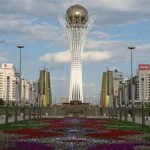Kapok Tree Diplomacy
Exploring the conduct of international relations and the ideals of democracy & individual liberty in the context of the Christian worldview.

Categories
Disclaimer
The posts, views and opinions expressed on this site are completely my own and do not represent the views or opinions of my employer, the Department of Defense (DoD), any member of the Armed Forces, or any company that is part of the defense industrial base.
Other Site Pages
-
Recent Posts
- Reflections on the Israel-Hamas Conflict in Gaza and Stray Voltage on Genocide, Proportionality, Apartheid, Collective Punishment, and the Impact of the (Demise of) the Right of Conquest November 7, 2023
- Availability of Articles for Download December 20, 2018
- Competing Visions for U.S. Grand Strategy March 13, 2015
- China’s Assertion of Sovereign Authority in the Global Commons and the Escalation of Legal Warfare in the Arctic October 2, 2013
- Theodore Roosevelt “Citizenship in a Republic” Speech May 9, 2013
Recent Comments
- admin on Ecuador and China: BFFs and Champions of the 21st Century Socialist Agenda
- Bryan Stewart on Ecuador and China: BFFs and Champions of the 21st Century Socialist Agenda
- admin on Ecuador and China: BFFs and Champions of the 21st Century Socialist Agenda
- Mike Warren on Ecuador and China: BFFs and Champions of the 21st Century Socialist Agenda
- amaka chukwujekwu on Is International Relations a Science?
Like Kapok Tree Diplomacy on Facebook
Subscribe to Blog via Email
Featured Posts
Admin
Kapok Tree Monthly Archive
 Lawfare Blog on Armed Conflict
Lawfare Blog on Armed Conflict- ChinaTalk: DOJ vs Data Espionage April 24, 2024The DOJ is now charged with protecting American data from foreign adversaries. This new proposed rule they recently issued is, according to one observer, “one of the most ambitious and sweeping new initiatives in national security law over the past few years.”To discuss, we interviewed Devin DeBacker and Lee Licata of the Department of Justice’s […]
- ChinaTalk: Japan's Resurgent Tech Scene April 24, 2024Ryan Takeshita is the Chief Global Editor at PIVOT, a new media outlet in Japan focused on the emerging startup scene.We get into:• A stroll through recent economic history leading to today's 'boom times'• Why more people are looking to leave traditional occupations for insurgent firms• Challenges around demographics and immigrationOuttro Music:Idol by Yaosobi https://open.spotify.com/track/1hAloWiinXLPQUJxrJReb1?si=36552bdc34cb4a73Matsuri […]
- Nuclear Friend-Shoring? Issues With Uranium Enrichment Cooperation April 24, 2024The U.S. could cooperate with foreign partners on uranium enrichment to wean nuclear power plants off Russian fuel. But should it?
- ChinaTalk: DOJ vs Data Espionage April 24, 2024
 Christian Post World News
Christian Post World News- Biden stokes outrage for making sign of the cross at pro-abortion rally: 'Truly sacrilegious' April 24, 2024President Joe Biden drew outrage and accusations of sacrilege for making the sign of the cross during a pro-abortion speech at his campaign rally in Florida on Tuesday. #JoeBiden #abortion #Catholicism #Florida
- Supreme Court weighs scope of Idaho abortion law in first major case since Roe v. Wade reversal April 24, 2024The U.S. Supreme Court's left-leaning justices grilled Idaho's attorney general over the state's refusal to accept federal guidance requiring emergency abortions as he maintains that the federal government can't require hospitals to conduct procedures that violate state law. #EMTALA #SupremeCourt #abortion #Idaho #progressives #Kagan #Sotomayor
- US set to withdraw from Niger as report reveals American troops 'stranded' amid military coup April 24, 2024The United States is set to withdraw its military presence from Niger following the release of a report raising questions about U.S. military operations in the African country and warning that troops are on the verge of running out of basic necessities as they remain “stranded” there amid a military coup. #Niger #MattGaetz #AntonyBlinken #Biden […]
- Episcopal House of Deputies president opponent wants to end 'unhealthy corporate culture' April 24, 2024The president of The Episcopal Church House of Deputies is facing an election opponent who is seeking to end what she describes as an “unhealthy corporate culture” within the denomination. #EpiscopalChurch #election #president #HouseofDeputies #RachelTaberHamilton #JuliaAyalaHarris
- Idaho pastor Gene Jacobs found dead after search and prayers April 24, 2024A congregation in Idaho is in mourning after authorities found its pastor dead Tuesday hours after he was reported missing to authorities. #Pastorkilled #GeneJacobs #dead #Idaho #Crime #RealLifeMinistries
- Kirk Franklin draws ire of Christians for dress, gyrating performance at Jamaican gospel concert April 24, 2024Gospel artist Kirk Franklin is drawing the ire of conservative Christians in Jamaica for gyrating and flexing his biceps while ministering in a tank top and shorts at “Fun in the Son,” a popular annual gospel concert sponsored by Best Dressed Chicken, a brand of the company, Jamaica Broilers Group, which is well-known for their […]
- The Christian Post wins Evangelical Press Association awards for online news, podcast and article series April 24, 2024The Christian Post won four awards at this week's Evangelical Press Association Christian Media Convention in Lexington, Kentucky, an annual conference attended by a wide variety of Christian newspapers, magazines, nonprofits and publishers. #TheChristianPost #EvangelicalPressAssociation #EPA #Award
- Biden stokes outrage for making sign of the cross at pro-abortion rally: 'Truly sacrilegious' April 24, 2024
 Charisma News
Charisma News- EndTime Confusion, Biden's Blunder and Former Witch Leads HUGE Beach Baptisms April 21, 2024http://www.CharismaNews.com for breaking news from a spiritual perspective 3. End-Times Confusion and the Great American Eclipse https://www.charismanews.com/opinion/94709-end-times-confusion-and-the-great-american-eclipse 2. The Danger of Biden's Blasphemous Easter Scandal https://www.charismanews.com/us/94717-the-danger-of-biden-s-blasphemous-easter-scandal 1. 'Waves of Glory': Former Witch Baptizes 200 People at Easter Sunrise Service on Clearwater Beach https://www.charismanews.com/us/94723-waves-of-glory-former-witch-baptizes-200-people-at-easter-sunday-service-on-clearwater-beachCharisma Podcast Network
- The Eclipse Passed What's Next? Destruction in Damascus? End Times Near? Top of the Week April 20, 2024Go to www.CharismaNews.com for the full stories! 5. Solar Eclipse Finds Its Center in the Empty Cross https://www.charismanews.com/us/94769-the-eclipse-and-the-coming-king 4. Prophetic Pulse: The Destruction of Damascus? https://www.charismanews.com/world/94767-prophetic-pulse-the-destruction-of-damascus 3. Almost Everyone Missed One of the Main Points of the Eclipse https://www.charismanews.com/us/94792-almost-everyone-missed-one-of-the-main-points-of-the-eclipse 2. The Supernatural Love Story of Joni Lamb and Doug Weiss https://www.charismanews.com/culture/94789-the-supernatural-love-story-of-joni-lamb-and-doug-weiss 1. Joseph Z: Earthquakes, […]Charisma Podcast Network
- Unveiling The Truth About The Great American Eclipse April 19, 2024Join James Lasher with Charisma Media as he delves into the aftermath of the Great American Eclipse of 2024. Discover the intriguing theories and messages that emerged before and after the eclipse. Subscribe now for more insightful discussions on celestial events! Clip used from Bishop Alan Didio sermon - Link https://www.youtube.com/live/VsTUIB52In8?si=_Kc_ywb_tjFmLUtj @EncounterTodayTVCharisma Podcast Network
- MegaChurch Controversy - Arrests Made in Missing Pastor's Wife Case and More! April 18, 2024MegaChurch Controversy - Arrests Made in Missing Pastor's Wife Case and More Go to http://www.CharismaNews.com 3. Missing Pastor's Wife and Friend Confirmed Dead, Police Make 4 Arrests https://www.charismanews.com/us/94854-missing-pastor-s-wife-and-friend-confirmed-dead-police-make-4-arrests 2. 'A True General of the Lord': Evangelist Jerry Savelle Dies at 77 https://www.charismanews.com/culture/94859-a-true-general-of-the-lord-evangelist-jerry-savelle-dies-at-77 1. Megachurch Scandal Erupts at Iconic Gathering https://www.charismanews.com/us/94852-megachurch-scandal-erupts-at-iconic-gatheringCharisma Podcast Network
- EndTime Confusion, Biden's Blunder and Former Witch Leads HUGE Beach Baptisms April 21, 2024
Meta




International and Regional Mechanisms for Holding Human Rights Offenders Accountable
“International and Regional Mechanisms for Holding Human Rights Offenders Accountable” by Kapok Tree Diplomacy
PREVIEW [Includes Table of Contents] Full essay is 2,825 words. 10 pages double-spaced. 12 references
Section One – United Nations Charter-Based and Treaty-Based Bodies
Charter-Based Institutions. These institutions include the UN General Assembly (GA), the UN Security Council (UNSC), the International Court of Justice (ICJ), the Human Rights Council (HRC), and other authorized bodies created by them such as the Commission on the Status of Women (CSW) (Steiner, Alston & Goodman (SAG) 737). “The single most important contribution made by the Charter-based bodies … has been through the elaboration of an ever-growing body of standards designed to flesh out … the norms enunciated in the Universal Declaration” (SAG 742). Each institution differs in its accountability processes.
Processes for Obtaining Justice
Fact-Finding
Fact-finding, is often subject to numerous obstacles such as government secrecy, availability of witnesses and lack of evidence that can negatively impact its credibility (SAG 749). Special rapporteurs may be appointed by UN bodies to conduct the mission, but even they may be intimidated and inhibited in their freedom of movement and inquiry (SAG 752).
1503 and 1235 Procedures
The 1503 procedure investigates “situations which appear to reveal a consistent pattern of gross and reliably attested violations” that may come from “any person or group who is a victim or has direct and reliable knowledge of violations” (SAG 755). The procedure is slow and lightly used and has also been accused by Amnesty International of being a “screen of confidentiality” that allows violations to continue. The 1235 procedure examines gross violations in a range of states and allows special rapporteurs to present detailed findings and recommendations to the HRC on an annual basis (SAG 760). Shaming can have an impact.
Table of Contents
I. United Nations Charter-Based and Treaty-Based Bodies
A. Charter-Based Institutions
B. Processes for Obtaining Justice
1. Fact Finding
2. 1503 and 1235 Procedures
3. Special Procedures
C. UN Human Rights Council
D. UN Security Council
E. ICCPR Human Rights Committee
II. Regional Human Rights, Courts and Councils
A. European Court of Human Rights (ECHR)
B. Inter-American Court of Human Rights (IACtHR) and Inter-American Commission on Human Rights (IACHR)
III. The Impact of Tradition and Culture
IV. Accountability for Human Rights Violations During Armed Conflict
V. Conclusion
The posts, views and opinions expressed on this site are completely my own and do not represent the views or opinions of the Department of Defense (DoD), the Department of the Navy (DON) or any of the Armed Forces.
Share this:
Like this: